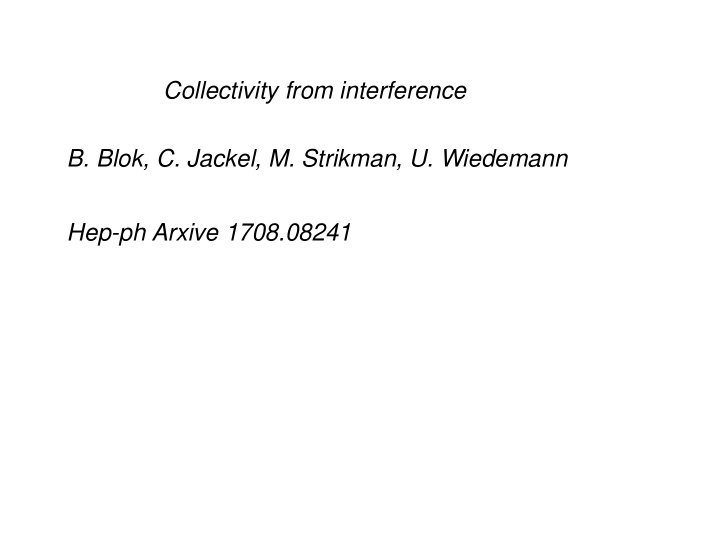



Collectivity from interference B. Blok, C. Jackel, M. Strikman, U. Wiedemann Hep-ph Arxive 1708.08241
Pictures from CMS 2016
Ridge correlations were first found in A-A collisions at RHIC , And since are considered important sign of creation of Quark-Gluon Plasma. They are successfully described by hydrodynamic model . Jet quenching in AA collisions is another sign of creation of QGP. So both-jet quenching and success of hydrodynamics — signs of large final state interactions/final state rescattering. Recently using kinetic equations it was possible to derive hydrodynamic model from final state interactions (G.Moore, A. Kurkella and their collaborators), taking as a basis bottom-up termalization scenario (Baier,Mueller,Schiff,Son). Ridge- 1) long range i.e. rapidity-independent correlations 2) transverse momentum correlations of created hadrons, described by cumulants, measured by experimentalists for N=2,4,6,.. However ridge was found also in pp and pA collisions at LHC (along with AA collisions) by all 3 collaborations: CMS(2012), Alice (2013), ATLAS (2013). Paradox-1) there is no evidence for large final state interactions in pp and probably In pA 2)jet quenching coefficient in both pp and pA is equal to R=1 So hydrodynamical interpretation of ridge in pp and pA collisions looks unnatural (A. Mueller InInitial Stages, Lissabon) Question: can ridge have different origin on pp than in AA?
Indeed, there were several attempts to explain ridge correlations in pp: 1) Hydrodynamics 2) transport models (all need large final state interactions) 3) High density Color Glass Condensate approach (Altinoliuk,Armesto,Beuf, iancu,Kovner,Lublinsky, Jalalian-Marian,Levin,Gotsman, Tribedi,Venugopalan, … ) Hoewer: such an approach means that saturated initial state is needed to describe Underlying Event in pp collisions at LHC. On the other hand we know for quite A long time that UE is well described by MC generators, that work in dilute regime (small relative to CGC gluon densities) 4) The same problem is in applying strongly coupled paradigms i.e. ADS/CFT-radical change of known description of UE by MC generators Another way-Low density scenario, Collectivity from interference – This Talk 1. No initial density, no initial asymmetry, no final state interactions 2. The cumulants narurally come from quantum-mechanical (QM) interference and color correlations. Hence:1)does not imply jet quenching in pp/pA 2) natural extension of MC generators, that contain in UE up to 10-20 MPI events (Sjostrand) The interference occurs not between gluons radiated by separate partons, but between different Hard processes, i.e. different MPIs, which we call “ sources ” .
Basic ideas about MPI geometry used in this talk : 1. Hadronic cross sections with N hard processes simultaneously are characterized by N=2 case is called DPS and characterized by The Generalized parton distributions GPD encode geometry of the process.We work Here in mean – field approximation neglecting 1-2 mechanism (Ladder splitting, probably not so big in UE) Number compatible to LHC data
In coordinate space: We work in the case b=0 (central collisions)
Basic ideas of the model: Assume LPHD Gluon emission Coulombic radiation:
Cumulants: Norm: Second cumulant: 4 th cumulant Higher cumulants – in the same way, see Ollitrault and his collaborators.
Dipole interference term
Direct calculation: m=2 N=2 Dipole color suppression Final answer :
N=2, arbitrary m, diagonal gluons
4 th cumulant and collectivity. Full result in large N limit Color correction factors can be determined explicitly as for dipole
Fourth order cumulant in leading order in However direct calculation shows that term is zero
So first nonzero term is: This term appears only in limit This term is negative and we have collectivity
Odd harmonics
Different color factors lead to breaking of a k -k symmetry present in large N limit, and appearance of sinuses: However: odd harmonics are parametrically suppressed by 1/N
Conclusions We calculated QCD interference effects based on MPI and found that 1. We have the correct form for 2 point cumulant 2. Collectivity-4 th cumulant is negative 3. The cumulants calculated with MPI parameters have correct order of magnitude 4. Odd harmonics naturally appear as a result of nonabelian nature of the model. We see that no-interaction baseline including QCD/QM interference effects due to different MPIs make significant if not dominant contribution in ridge in pp and pA. Our model disentangles in calculation of cumulants QCD interference effects from effects that depend on parton density in initial state. Its relation to other approaches, such as CGC can be further clarified. Further tasks: get closer to phenomenology, more rigorous derivation of our model from QCD, further understanding of final states in pp collision, effects of 1/N, hadronization/LPHD,………..
Recommend
More recommend